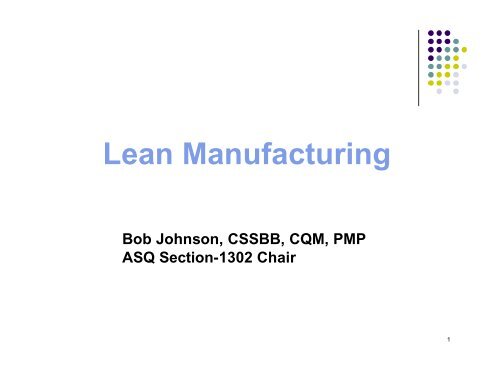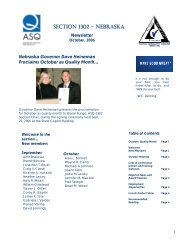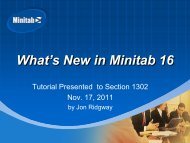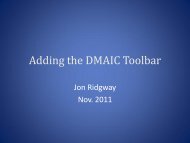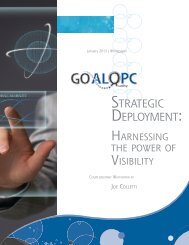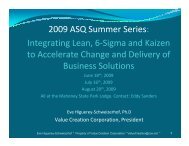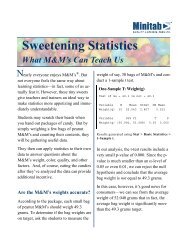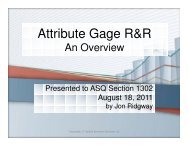Lean Manufacturing Presentation - ASQ-1302
Lean Manufacturing Presentation - ASQ-1302
Lean Manufacturing Presentation - ASQ-1302
You also want an ePaper? Increase the reach of your titles
YUMPU automatically turns print PDFs into web optimized ePapers that Google loves.
<strong>Lean</strong> <strong>Manufacturing</strong><br />
Bob Johnson, CSSBB, CQM, PMP<br />
<strong>ASQ</strong> Section-<strong>1302</strong> Chair<br />
1
Overview<br />
� The Why and What of <strong>Lean</strong> Thinking<br />
� 8 Categories of Waste<br />
� The Tools of <strong>Lean</strong> Thinking<br />
2
Where did <strong>Lean</strong> Thinking originate?<br />
� Originally started by Henry Ford (1911)<br />
� Developed by Taiichi Ohno, Toyota (1942)<br />
� Developed in Textile Industry not Automotive<br />
� Developed as a response to “slow growth”<br />
economic theory<br />
� Goal: Produce variety cheaply<br />
3
<strong>Lean</strong> Thinking Benefits<br />
� Cost Reduction<br />
� Cycle Time Reduction<br />
� “Waste” Minimization (Waste Killer)<br />
� Elimination of Non-Value Added Activities<br />
Resulting in a more “lean”, agile, quickresponse<br />
and competitive company<br />
4
Why the Emphasis on <strong>Lean</strong> Now<br />
� Global/Internet Economy<br />
� Pressure from customers for price reduction<br />
� Fast-paced technological changes<br />
� Increased expectations of customers<br />
� Continued focus on Quality, Cost and Delivery<br />
� Quality Standards like ISO 9000:2000<br />
5
Definition<br />
<strong>Lean</strong> thinking is aimed at the elimination of waste<br />
in every area of production or service including<br />
customer relations, service design, supplier<br />
networks, service delivery and factory<br />
management. Its goal is to incorporate less<br />
human effort, less inventory, less time to develop<br />
products and services, and less space to become<br />
highly responsive to customer demand while<br />
producing top quality products and services in the<br />
most efficient and economical manner possible.<br />
Adapted from Production System Design Laboratory<br />
Massachusetts Institute of Technology<br />
6
Definition<br />
A systematic approach to identifying and<br />
eliminating waste (non-value-added-activities)<br />
through continuous improvement by flowing the<br />
product at the pull of the customer in pursuit of<br />
perfection<br />
<strong>Manufacturing</strong> Extension Partnership (MEP) Definition<br />
7
Definition of Value Added<br />
Value Added<br />
Any activity that increases the fit, form or function<br />
of the product or service. (These are things the<br />
customer is willing to pay for.)<br />
Non-value added<br />
Any activity that does not add to the fit, form or<br />
function or is not necessary. (These activities<br />
should be eliminated, simplified, reduced or<br />
integrated.)<br />
8
Value vs Non-Value Breakout<br />
Value Added<br />
Non-Valued Added<br />
� Overproduction<br />
� Waiting<br />
� Transportation<br />
� Process<br />
� Unneeded Movement of<br />
People/Parts<br />
� Excessive Inventory<br />
� Defective Products or<br />
Services<br />
� Underutilized People<br />
Typically 95% of all lead time is non-value added<br />
9
Typical Process<br />
Service<br />
� Long Cycle Times<br />
� Process not flexible<br />
� Lots of Wait Time<br />
<strong>Manufacturing</strong><br />
� Batch Processing<br />
� Inventory - Safety<br />
Stocks<br />
� Lots of Wait Time<br />
� Material inspected at<br />
the end<br />
10
Categories of Waste<br />
(7 Muda plus one)<br />
� Overproduction<br />
� Waiting<br />
� Transportation<br />
� Process<br />
� Unneeded Movement of People/Machines<br />
� Excessive Inventory<br />
� Defective Products or Services<br />
� Underutilized People<br />
11
Overproduction<br />
Making more/earlier/faster than is<br />
required by the next process<br />
Causes of Overproduction<br />
� Just in case logic<br />
� Misuse of automation<br />
� Long Process Setup<br />
� Un-level Scheduling<br />
� Unbalanced workload<br />
� Over Engineering<br />
� Redundant Inspections<br />
12
Waiting<br />
Idle Time Created by Waiting For …<br />
Causes of Waiting Waste<br />
� Unbalanced workload<br />
� Unplanned Maintenance/Computer Downtime<br />
� Misuse of automation<br />
� Long Process Setup Times<br />
� Un-level Scheduling<br />
� Upstream Quality Problems<br />
13
Transportation<br />
Transporting parts and materials<br />
around the plant<br />
Causes of Transportation Waste<br />
� Poor Plant Layout<br />
� Poor Understanding of the Process Flow for<br />
Production or Service<br />
� Large Batch Sizes<br />
� Long Lead Times<br />
� Large Storage Areas<br />
14
Process Waste<br />
Efforts that add no value to the product<br />
or service from the customers’<br />
viewpoint<br />
Causes of Process Waste<br />
� Product Changes Without Process Changes<br />
� Just-in-Case Logic<br />
� True Customer Requirements not Clearly Defined<br />
� Over-Processing to Accommodate Downtime<br />
� Redundant approvals<br />
� Extra Copies/Excessive Information<br />
� Lack of communication<br />
15
Unneeded Movement<br />
Any movement of people, parts, or<br />
machines that does not add value to<br />
the product or service<br />
Causes of Motion Waste<br />
� Poor People/Machine Effectiveness<br />
� Inconsistent Work Methods<br />
� Unfavorable Facility or Work Center Layout<br />
� Poor Workplace Organization and Housekeeping<br />
� Extra “Busy” Movements While Waiting<br />
16
Excessive Inventory<br />
Any supply in excess of a onepiece<br />
flow through your process<br />
Causes of Excess Inventory<br />
� Just-in-Case Logic<br />
� Poor Market Forecast<br />
� Unbalanced Workload<br />
� Misunderstood Communications<br />
� Wrong Reward System<br />
� Unreliable shipments by suppliers<br />
17
Defective Products/Services<br />
Inspection, Rework, Scrap of material,<br />
process or product<br />
Causes of defects<br />
� Weak Process Control<br />
� Poor Quality<br />
� Unbalanced Inventory Levels<br />
� Poor Education/Training/Work Instructions<br />
� Wrong Reward System<br />
� Product/Process Design<br />
� Misunderstood customer requirements<br />
18
Underutilized People<br />
Not using people’s mental,<br />
creative, and physical abilities<br />
Causes of People Waste<br />
� Old Guard Thinking, Politics, Culture<br />
� Poor Hiring Practices<br />
� Unbalanced Inventory Levels<br />
� Low or no investment in Education/Training<br />
� Wrong Reward System<br />
� Low pay, High Turn-Over Strategy<br />
19
Value Stream Mapping<br />
What are the steps that add value to<br />
the process?<br />
� Map the Current State<br />
� Identify Non Value Added (NVA) Steps<br />
� Reduce or eliminate NVA<br />
� Map the Future State<br />
20
Value Stream Mapping Vs Process<br />
Mapping<br />
Helps you visualize the material and<br />
information flow<br />
� Simple<br />
� Visual<br />
� Adds Takt Time (available production time<br />
divided by rate of customer demand) to<br />
Process Map<br />
� Adds Information Flow<br />
21
Theory of Constraints<br />
Helps you visualize the bottle necks in<br />
the process and information flow<br />
� Demand on a resource greater than capacity<br />
(backlogs throughout system)<br />
� Subsequent event depend on prior ones<br />
� Identify system constraints, use non-constrained<br />
resources, increase capacity, subordinate other<br />
resources to constraint, or improve process of<br />
constrained resource<br />
22
5S-Workplace<br />
A System for workplace organization and<br />
standardization<br />
� Seiri – (Sort) Separate needed from the unneeded, get rid of<br />
unneeded<br />
� Seiton – (Set in order) Neatly arrange and identify parts for<br />
ease of use<br />
� Seiso – (Shine) Clean working environment (house keeping)<br />
� Seiketsu – (Standardize) Make all work simple and uniform<br />
� Shitsuke – (Sustain) Make it easy to follow the standard work<br />
flow<br />
23
Visual Workplace<br />
Placing all parts, production<br />
activities and performance<br />
indicators out in plain view<br />
� Self-Explaining<br />
� Self-Ordering<br />
� Self-Regulating<br />
� Self-Improving<br />
� Where what is supposed to happen – does<br />
happen every time<br />
24
Batch Size Reduction<br />
A System for making one and<br />
moving one for continuous flow<br />
� Best Batch Size is One<br />
� Flexible<br />
� Detect Defects Earlier<br />
� Shorter Lead Times<br />
25
Quality at the Source<br />
A System for making operators<br />
responsible and empowered to<br />
ensure quality<br />
� Inspection by Operators<br />
� Doesn’t move unless acceptable quality<br />
� Visible samples/standards used<br />
� Need quality inspection requirements<br />
defined for each work station<br />
26
Point of Use Storage<br />
System for storing raw materials<br />
where they are needed<br />
� Stored are workstation where used<br />
� Supplier relationship permits frequent, ontime,<br />
small shipments<br />
� Simplifies Physical Inventory Tracking<br />
� Simplifies storage and handling<br />
27
Single Minute Exchange of Dies<br />
System for quick changeover to a<br />
different product or service<br />
� SMED is changing a process to produce a<br />
different product in the most efficiently<br />
� The amount of time between last good part<br />
to first good part of next set-up<br />
� Try for under 10 minutes (Bob’s Tire vs Pit<br />
Crew)<br />
28
Cellular Flow<br />
System for moving equipment or<br />
processes in most efficient way<br />
� Physically linking of manual and machine<br />
operations<br />
� Looking for most efficient combination<br />
� Maximize value added and minimizing<br />
waste<br />
29
Total Productive Maintenance<br />
System to maximize equipment<br />
effectiveness and machine life<br />
� Everyone participates in TPM from top<br />
executives to shop floor operator<br />
� Involves all departments<br />
� Eliminate breakdowns, defects and<br />
accidents<br />
� Maximize production system efficiency<br />
30
Poka-Yoke (Mistake Proofing)<br />
System to make it more difficult<br />
to make mistakes or defects<br />
� Right part goes in on only one way<br />
� Part can only be positioned correctly<br />
� Machine/System controlled (laser eye)<br />
� Color coding/buzzer/lights as signals<br />
� Automatic vision system inspection<br />
31
Kaizen<br />
System of continual incremental<br />
improvement of an activity<br />
� Improve Value<br />
� Reduce Waste<br />
� Kaizen Blitz – dedicated process to find<br />
process improvements<br />
� Gemba Kaizen – Close to the action<br />
improvements<br />
32
Kanban<br />
System of tickets or signals to<br />
order or stage inventory<br />
� Reduces inventory<br />
� Ensures inventory is ordered as needed<br />
� Can be used for all resources; materials<br />
equipment, information, reports, etc.<br />
� Supplier managed or consignment<br />
inventory is not Kanban<br />
33
QUESTIONS<br />
34


